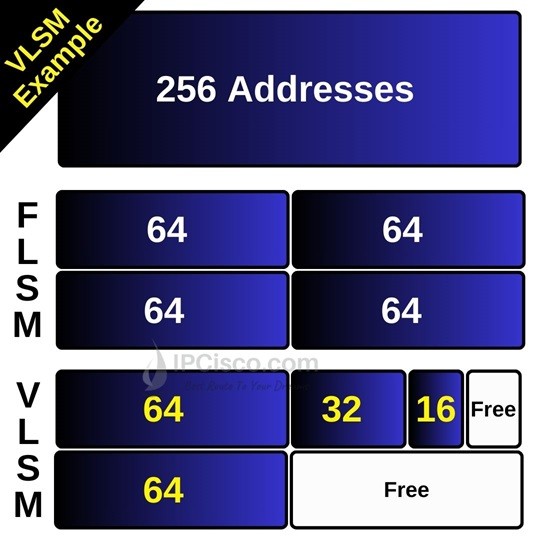- COURSES
- SPECIALS
- BLOG
- MEMBERS
- SHOP
- ABOUT
- ENROLL HERE

VLSM is the abbreviation of Variable Length Subnet Mask. In this subnetting lesson, we will focus on what is VLSM, what is FLSM? Why we use VLSM and more. VLSM subnetting is an important lesson of ip subnetting and in other subnetting lessons, we have used this important term a lot. Here, we will learn what is VLSM (Variable Length Subnet Mask) detailly.
As you know, internet is growing rapidly and this causes a lot of online devices. To be online in internet, that device need to have an ip address and this has caused IPv4 address exhaust. So, a new ip version, ipv6 has developed.
Although this development, we can use an efficient subnetting technique to overcome wasting ip addresses. Here, VLSM (Variable Length Subnet Mask) is joining the game. Let’s start with FLSM and then VLSM Subnetting.

To calculate ip address subnetting easily, DOWNLOAD Subnet Cheat Sheet!
Table of Contents
FLSM is the abbreviation of Fixed Length Subnet Mask. With FLSM technique, all the subnets use the same subnet masks. In other words, when we divide an ip address to create different subnets, all the subnets are equal.
This method provides different subnets but does not prevent waste of ip addresses.
Think about that we have an ip address 192.168.1.0/24. And we have four departments each need a different subnet. So, we need four subnets. Here, totally we have 256 ip addresses according to our subnet mask 255.255.255.0 (/24).
If we use FLSM (Fixed Length Subnet Mask), we can create four equal subnets with 255.255.255.192 subnet mask (/26). Here, in each subnet there will be 64 ip addresses available.
But here, there is an ip address waste. Because, there can be less ip address need in each subnet. Although, this less need, we have to use the same subnet mask with 64 available ip address.
What if we use VLSM instead of FLSM to save our ip addresses? In the following parts, you will see how we save our ip address space with the help of VLSM Subnetting.
So, what is VLSM? Why we use VLSM? Variable Length Subnet Mask is basically a technique with which we can use our ip addresses efficiently. So, how do we do this?
Before, we use the same subnet mask for all the parts of divided subnets. In other words, we were using the same subnet masks for each part. Now, think about a technique with which we can create subnets with different subnet masks. Isn’t it so efficient? With this technique, according to the requirement, we can save a lot of ip address with smaller subnets and larger subnets masks.
In traditional subnetting technique, if you have a class C ip address, your subnet mask is fixed 255.255.255.0. The CIDR value of this subnet mask is /24. This means, in a subnet, there are 254 available host ip addresses. But what if you need few ip addresses? For example, if you have only 10 users, this usage will be an inefficient way of ip addressing. So, here, we use VLSM not to waste the remaining ip addresses. For this example, we can select the closest multiple of two and it is 16. In other words, we will use a subnet mask which will allow 16 available ip address. With 16 available ip addresses, we can use 14 ip addresses for hosts. The remaining two ip addresses are for network and broadcast ip addresses. If we select 8, then it will not satisfy our requirement.
To have 16 ip addresses in a subnet, we need two to the power of four. This means, 4 host bits in the subnet mask (11111111.11111111.11111111.1111.0000). Here, our subnet mask will be 255.255.255.240. The CIDR value of this subnet mask is /28.
To calculate ip address subnetting easily, DOWNLOAD Subnet Cheat Sheet!
To understand what is VLSM, let’s do another example. Here, our company has an ip address 192.168.1.0/24. We will use this ip address for four different departments of the company. Engineering, Sales, Accounting and HR. Engineering has 60 users, Sales has 40 users, Accounting has 20 users and HR has 10 users. According to these needs, let’s use our ip address space efficiently by using VLSM.
Here, we will use the below subnet masks and CIDR values for each department:
Let’s write the ip addresses of each subnet.
Engineering (/26 255.255.255.192)
Sales (/26 255.255.255.192)
Accounting (/27 255.255.255.224)
Engineering (/28 255.255.255.240)
If we have used FLSM, our subnets will use /26 and each one will have 64 available ip address. And all our ip address spaced will be consumed. But with VLSM Subnetting, we will save many ip addresses.
Used ip addresses: 192.168.1.0-192.168.1.175
Free ip addresses: 192.168.1.176-192.168.1.255
To be better on ipv4 subnetting, you can practice on Subnetting Questions Page!
There are different characteristics of these two techniques if we compare FLSM versus VLSM. What are these differences? Below, you can find the differences of VLSM and FLSM.
With traditional FLSM, we can divide any subnet into equal parts only. We can not create different sized subnets. But with VLSM Subnetting, we can create multiple different sized subnets.
Because of the fact that all the subnets are equal, same subnet mask is also used with FLSM. But for VLSM, different subnet mask can be used according to the need.
If we use FLSM, the new subnet’s host numbers are equal. But with VLSM, there can be different host numbers in each subnet.
FLSM is easier than VLSM if we compare the operation of these two techniques. But to save ip addresses, this difficulty is not too much for VLSM Subnetting.
At the end of the day, FLSM results in waste of ip addresses while VLSM saves our ip address space.
To start learning Network Fundamentals, visit Cisco CCNA Certification Course!
Leave a Reply